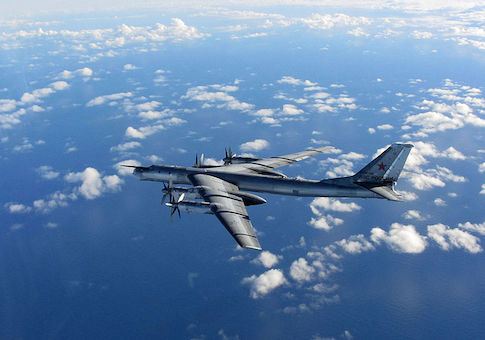Two Russian nuclear-capable bombers intruded into the U.S. air defense zone near Alaska last week in the latest saber rattling by Moscow, defense officials said.
The Tu-95 Bear H bombers flew into the Alaska zone on April 22. But unlike most earlier incursions, no U.S. interceptor jets were dispatched to shadow them, said defense officials familiar with the latest U.S.-Russian aerial encounter.
Navy Capt. Jeff Davis, a spokesman for the U.S. Northern Command and North American Aerospace Defense Command (NORAD), declined to confirm the incursion. But he said no jets were dispatched last week to intercept intruding aircraft.
The incident was the first Russian bomber incursion of a U.S. or Canadian air defense zone this year. Officials said it likely signals the start of Russia’s long-range aviation spring training cycle. Further aerial incursions are expected.
Last year, U.S. and Canadian jets intercepted Russian bombers on at least six occasions, and intruding Russian long-range aircraft were detected on 10 occasions, Davis said.
Despite remaining in international airspace, "we believe that if the Russian military filed flight plans and self-identified—by ‘squawking and talking’—the overall safety of flight would be enhanced," Davis said.
"And it could also reduce the number of times we scrambled fighter jets to intercept the aircraft, thereby reducing the potential for miscalculation."
Davis said the increase in flights near North America coincided with Russia's incursion into the Ukraine and Crimea.
"These flights often enter the U.S. or Canadian [air defense identification zone], but have not entered U.S. or Canadian sovereign airspace," he said, adding that the flights are legal since the ADIZ is not sovereign airspace.
Last year’s intercepts included the following encounters, according to NORAD:
- On April 2, 2014, two U.S. F-22 fighters intercepted two Bear bombers west of Alaska’s coast.
- On June 9, 2014, two F-22s intercepted four Bears and one refueling tanker near Alaska. Two of the Bears later flew near the California coast and were intercepted by two F-15s.
- Early August 2014: NORAD notes a "spike" Russian aircraft operating in and around the U.S. ADIZ.
- On Sept 17, 2014, two F-22s intercepted two Russian IL-78 refueling tankers, two Russian Mig-31 fighter jets and two Bear long-range bombers in the ADIZ west of Alaska. The Russian aircraft flew a loop south, then turned west toward Russia.
- On Sept. 18, 2014, two Bears were intercepted and identified by two Canadian CF-18 fighters in the western reaches of the Canadian ADIZ, in the Beaufort Sea.
- On Dec. 8, 2014, two CF-18s intercepted two Bears near the Beaufort Sea off Canada's coast.
In Europe, the latest bomber encounter took place on April 14, when two British Typhoon jet fighters intercepted two Bear H bombers near British airspace.
A Russian embassy spokesman did not return an email seeking comment.
Senior military officials have said Russia has stepped up such bomber flights near U.S. coasts as part of a strategic messaging and influence operation.
Northern Command commander Adm. William Gortney told reporters April 7 that Russia is developing a far more capable military than its predecessor, the Soviet Union, which made up for its poor quality of troops and equipment by deploying very large numbers of forces, he said.
Moscow also has published a new military doctrine that explains the military annexation of Ukraine’s Crimea and covert backing of armed rebels in eastern Ukraine, Gortney said.
"At the same time, they are messaging us," the four-star admiral said. "They're messaging us that they're a global power—we do the same sort of thing—with their long-range aviation."
Both numbers of flights and numbers of locations for the bomber flights "have gone up," he said.
"So we watch very carefully what they're doing," Gortney said. "They are adhering to international standards that are required by all airplanes that are out there. And everybody is flying in a professional manner on their side and our side as we watch very closely."
"But really, my question is, what is their intent long-term-wise?"
The latest Bear bomber intrusion near Alaska followed the intercept of a U.S. RC-135 reconnaissance aircraft over Baltic Sea on April 7 that the Pentagon said was provocative and dangerous.
Gen. Martin Dempsey, chairman of the Joint Chiefs of Staff, said the Russian Su-27 jet conducted a "reckless" and "unprofessional" intercept of the RC-135 and noted that the Pentagon protested that U.S.-Russia aerial encounter.
Gen. Phillip Breedlove, commander of the U.S. European Command, told a Senate hearing Thursday that a "revanchist" Russia threat under Vladimir Putin is the most serious security worry facing the region.
"Russia is blatantly challenging the rules and principles that have been the bedrock of European security for decades," Breedlove told the Senate Armed Services Committee.
"This is global. It's not regional, and it is enduring, not temporary," he said. "Russian aggression is clearly visible in its illegal occupation of Crimea and its continued operations in Eastern Ukraine."
Breedlove said the Russians are waging "hybrid" warfare using both military forces and information operations. In Ukraine they have supplied proxies with significant assistance, he said.
"What worries me is Russia as a nation now adopting an approach that says they can and will use military power to change international borders," Breedlove said. "That's what I truly worry about every day."
